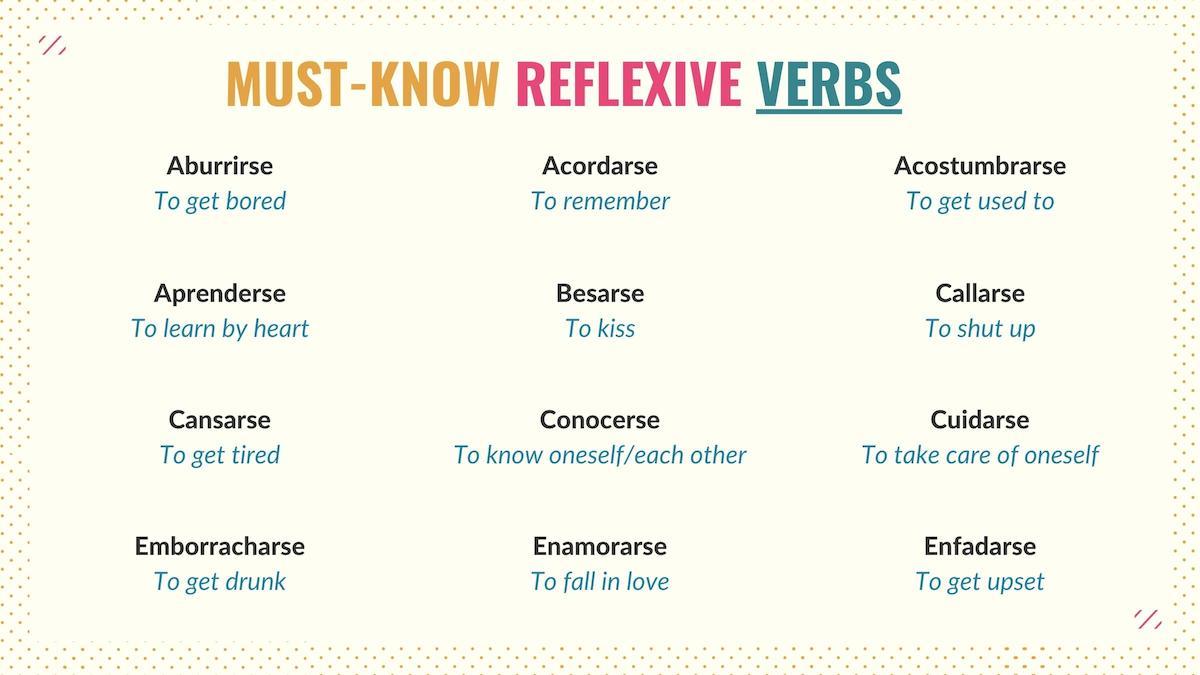Bosque de Palabras
Bosque de Palabras is a text adventure survival game designed to help you learn Spanish vocabulary and grammar while having fun!
In Bosque de Palabras, you're camping️ in the middle of a dark forest, with only a few pieces of food left and a campfire keeping you warm. Every choice you make is important for your survival.
Perfect for: Novice and Intermediate level Spanish learners.
Spanish Verbs That Change Meaning When Reflexive
Gordon Feliz • Updated Jan 23rd, 2024

In the fascinating journey of learning Spanish, one encounters the dynamic nature of verbs, particularly how their meanings can shift dramatically when used reflexively. Reflexive verbs are those that indicate that the subject of a sentence performs an action to itself, and in Spanish, this is often shown by adding reflexive pronouns like "me," "te," "se," "nos," "os," or "se." What makes these verbs intriguing is their ability to change meanings when used reflexively, offering a rich layer of expression. In this lesson, we'll explore several Spanish verbs that change meanings when they become reflexive, providing numerous examples to illustrate these variations.
Spanish Verbs That Change Meaning When Reflexive
Acostar / Acostarse
Acostar: to lay (someone) down
Example: "Ella acosta al bebé en la cuna." (She lays the baby down in the crib.)
Acostarse: to go to bed, to lie down
Example: "Me acuesto temprano durante la semana." (I go to bed early during the week.)
Llamar / Llamarse
Llamar: to call
Example: "Juan llama a su madre todos los días." (Juan calls his mother every day.)
Llamarse: to be called, to be named
Example: "Me llamo Carlos." (My name is Carlos.)
Poner / Ponerse
Poner: to put, to place
Example: "Pon el libro en la mesa." (Put the book on the table.)
Ponerse: to put on (clothing), to become
Example: "Me pongo mi chaqueta porque hace frío." (I put on my jacket because it's cold.)
Quedar / Quedarse
Quedar: to be located, to meet
Example: "¿Dónde queda el banco?" (Where is the bank located?)
Quedarse: to stay, to remain
Example: "Me quedo en casa hoy." (I'm staying at home today.)
Ir / Irse
Ir: to go
Example: "Voy al supermercado." (I'm going to the supermarket.)
Irse: to leave, to go away
Example: "Se van de la fiesta." (They are leaving the party.)
Pasar / Pasarse
Pasar: to pass, to happen
Example: "¿Qué pasó ayer?" (What happened yesterday?)
Pasarse: to go over, to cross a line
Example: "Se pasó de la raya." (He crossed the line.)
Dormir / Dormirse
Dormir: to sleep
Example: "Los niños duermen ocho horas." (The children sleep eight hours.)
Dormirse: to fall asleep
Example: "Me dormí en el cine." (I fell asleep in the cinema.)
Sentar / Sentarse
Sentar: to seat, to sit (someone)
Example: "Siento a mi abuela en la silla." (I seat my grandmother in the chair.)
Sentarse: to sit down
Example: "Me siento en el sofá." (I sit down on the sofa.)

Reflexive Verbs Practice Exercises
1. Acostar / Acostarse
Spanish: "Cada noche, _______ a mis hijos en sus camas antes de dormir."
English: "Every night, I lay my children in their beds before sleeping."
Spanish: "Después de un largo día de trabajo, _______ temprano."
English: "After a long day of work, I go to bed early."
Spanish: "Mi abuela siempre _______ al bebé en la cuna después de alimentarlo."
English: "My grandmother always lays the baby in the crib after feeding him."
2. Llamar / Llamarse
Spanish: "¿Cómo _______ tu mejor amigo?"
English: "What is your best friend called?"
Spanish: "Mañana _______ al doctor para confirmar mi cita."
English: "Tomorrow I will call the doctor to confirm my appointment."
Spanish: "En la fiesta, conocí a alguien que _______ igual que tú."
English: "At the party, I met someone who is named just like you."
3. Poner / Ponerse
Spanish: "Cuando llego a casa, me _______ ropa cómoda."
English: "When I get home, I put on comfortable clothes."
Spanish: "Por favor, _______ los platos en el lavaplatos."
English: "Please, put the dishes in the dishwasher."
Spanish: "Ella se _______ muy triste cuando escuchó las noticias."
English: "She became very sad when she heard the news."
4. Quedar / Quedarse
Spanish: "No sé dónde _______ la biblioteca en este barrio."
English: "I don’t know where the library is located in this neighborhood."
Spanish: "Este fin de semana me _______ en casa para relajarme."
English: "This weekend I’m staying at home to relax."
Spanish: "¿Dónde _______ para tomar un café mañana?"
English: "Where shall we meet to have coffee tomorrow?"
5. Ir / Irse
Spanish: "Ellos _______ de vacaciones a la playa cada verano."
English: "They go on vacation to the beach every summer."
Spanish: "Me _______ de la reunión porque estaba aburrida."
English: "I left the meeting because I was bored."
Spanish: "¿A qué hora _______ al supermercado?"
English: "What time are you going to the supermarket?"
6. Pasar / Pasarse
Spanish: "¿Qué _______ con el proyecto que estaban realizando?"
English: "What happened with the project they were working on?"
Spanish: "Se me _______ la hora y llegué tarde a la cita."
English: "I lost track of time and arrived late to the appointment."
Spanish: "A veces, los estudiantes se _______ hablando en clase."
English: "Sometimes, students go overboard talking in class."
7. Dormir / Dormirse
Spanish: "Los gatos _______ casi todo el día."
English: "Cats sleep almost all day."
Spanish: "Me _______ durante la película anoche."
English: "I fell asleep during the movie last night."
Spanish: "¿A qué hora suelen _______ tus niños?"
English: "What time do your children usually go to sleep?"
8. Sentar / Sentarse
Spanish: "Por favor, _______ a los niños en la mesa del comedor."
English: "Please seat the children at the dining table."
Spanish: "Después de caminar tanto, necesito _______ un rato."
English: "After walking so much, I need to sit down for a while."
Spanish: "El maestro _______ a los estudiantes en círculo para la actividad."
English: "The teacher seats the students in a circle for the activity."
Practice Exercises Answer Key
1. Acostar / Acostarse
Exercise 1:
Answer: "Cada noche, acuesto a mis hijos en sus camas antes de dormir."
Exercise 2:
Answer: "Después de un largo día de trabajo, me acuesto temprano."
Exercise 3:
Answer: "Mi abuela siempre acuesta al bebé en la cuna después de alimentarlo."
2. Llamar / Llamarse
Exercise 1:
Answer: "¿Cómo se llama tu mejor amigo?"
Exercise 2:
Answer: "Mañana llamo al doctor para confirmar mi cita."
Exercise 3:
Answer: "En la fiesta, conocí a alguien que se llama igual que tú."
3. Poner / Ponerse
Exercise 1:
Answer: "Cuando llego a casa, me pongo ropa cómoda."
Exercise 2:
Answer: "Por favor, pon los platos en el lavaplatos."
Exercise 3:
Answer: "Ella se pone muy triste cuando escuchó las noticias."
4. Quedar / Quedarse
Exercise 1:
Answer: "No sé dónde queda la biblioteca en este barrio."
Exercise 2:
Answer: "Este fin de semana me quedo en casa para relajarme."
Exercise 3:
Answer: "¿Dónde quedamos para tomar un café mañana?"
5. Ir / Irse
Exercise 1:
Answer: "Ellos van de vacaciones a la playa cada verano."
Exercise 2:
Answer: "Me voy de la reunión porque estaba aburrida."
Exercise 3:
Answer: "¿A qué hora vas al supermercado?"
6. Pasar / Pasarse
Exercise 1:
Answer: "¿Qué pasó con el proyecto que estaban realizando?"
Exercise 2:
Answer: "Se me pasó la hora y llegué tarde a la cita."
Exercise 3:
Answer: "A veces, los estudiantes se pasan hablando en clase."
7. Dormir / Dormirse
Exercise 1:
Answer: "Los gatos duermen casi todo el día."
Exercise 2:
Answer: "Me dormí durante la película anoche."
Exercise 3:
Answer: "¿A qué hora suelen dormir tus niños?"
8. Sentar / Sentarse
Exercise 1:
Answer: "Por favor, sienta a los niños en la mesa del comedor."
Exercise 2:
Answer: "Después de caminar tanto, necesito sentarme un rato."
Exercise 3:
Answer: "El maestro sienta a los estudiantes en círculo para la actividad."
Additional Resources To Learn More
How to Use Direct and Indirect Object Pronouns in Spanish: Understanding the use of object pronouns is fundamental in Spanish, especially when dealing with reflexive verbs. This article provides a clear explanation of how to use direct and indirect object pronouns, which is essential for correctly constructing sentences with reflexive verbs.
Beginner's Guide to Spanish Sentence Structure With Examples: A strong grasp of sentence structure is important for understanding the placement and impact of reflexive pronouns in sentences. This guide offers a foundational understanding of Spanish sentence structure, complemented by examples that can help learners see how reflexive verbs fit into broader linguistic patterns.
Spanish Stem-Changing / Irregular Reflexive Verbs on SpanishBoat: This resource provides a comprehensive list of Spanish stem-changing and irregular reflexive verbs. It categorizes them into types like e-ie, e-i, and o-ue stem-changing verbs, and gives examples of each, making it a great tool for understanding how these verbs work in different contexts.
Reflexive Verbs with Different Meanings on Spanish Language Blog (Transparent Language): This blog post details how certain Spanish verbs change their meanings when used in the reflexive form. It offers a list of verbs with examples in both their simple and reflexive forms, which can be very useful for grasping the subtle differences in meaning.


